Shock reducing strategies in devices
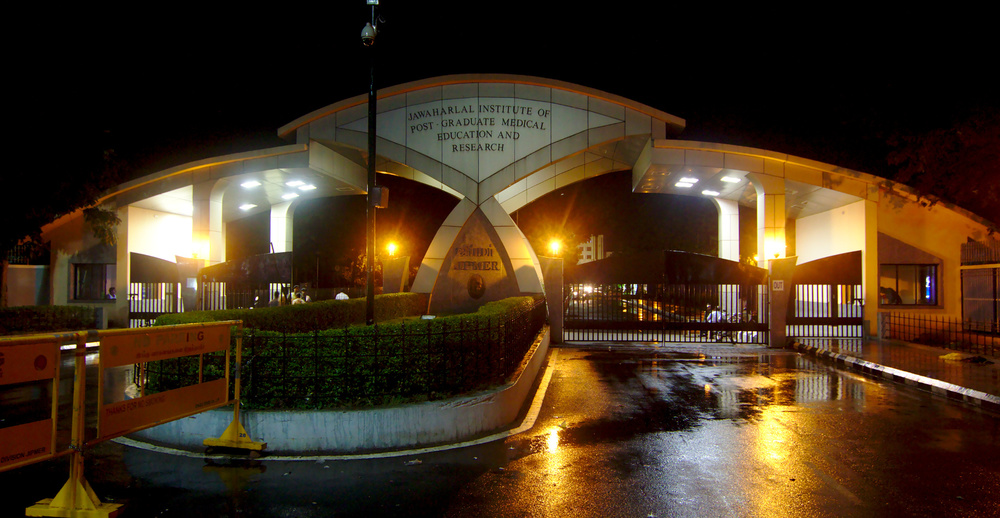
10-10-2020
Raja Selvaraj, JIPMER
ICDs designed to treat VF

Multiple functions of ICD
- Bradycardia pacing
- Anti-tachycardia pacing
- Cardioversion
- Defibrillation
Shocks prevalence
- A third of patients after 5 years
- About a fifth are inappropriate
"Shock paradox"
- Shocks worsen quality of life
- Myocardial damage occurs with shocks
- Shocks increase mortality
Increased mortality
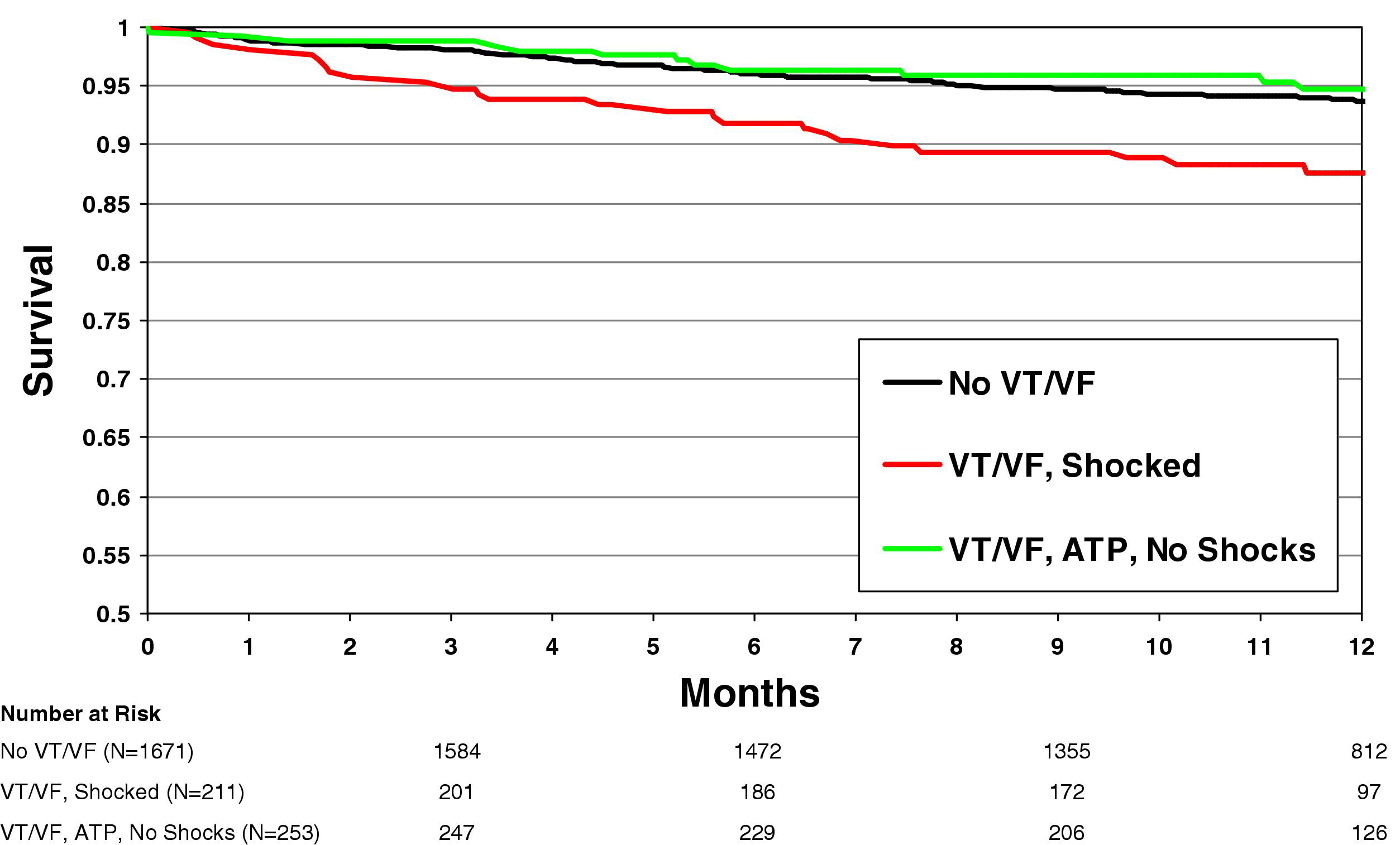
Sweeney MO, Sherfesee L, DeGroot PJ, Wathen MS, Wilkoff BL. Differences in effects of electrical therapy type for ventricular arrhythmias on mortality in implantable cardioverter-defibrillator patients. Heart Rhythm. 2010 Mar;7(3):353-60. doi: 10.1016/j.hrthm.2009.11.027. Epub 2009 Dec 2. PMID: 20185109.
Not all shocks save lives

Ellenbogen KA … , Kadish A; Defibrillators in Non-Ischemic Cardiomyopathy Treatment Evaluation (DEFINITE) Investigators. Are implantable cardioverter defibrillator shocks a surrogate for sudden cardiac death in patients with nonischemic cardiomyopathy? Circulation. 2006 Feb 14;113(6):776-82.
Shocks
- Inappropriate shocks
- Unnecessary, appropriate shocks
- Necessary appropriate shocks
Strategies to reduce shocks
- Control of ventricular arrhythmias
- Drugs
- Ablation
- Choosing the right device ?
- Device programming
Control of arrhythmias
ICD is not a treatment for VT
- Not for VT storm
- Not in presence of recurrent VT
Medical management
- Control VA before implant
- Heart failure treatment, AAD, beta blockers after implant
- Sotalol useful to reduce shocks (1)
- Amiodarone - Better than beta blocker alone or Sotalol - OPTIC trial (2)
- Pacifico A et al. Prevention of implantable-defibrillator shocks by treatment with sotalol. d,l-Sotalol Implantable Cardioverter-Defibrillator Study Group. N Engl J Med. 1999;340:1855–62. doi: 10.1056/NEJM199906173402402.
- Connolly SJ et al. Comparison of beta-blockers, amiodarone plus beta-blockers, or sotalol for prevention of shocks from implantable cardioverter defibrillators: the OPTIC Study: a randomized trial. JAMA. 2006;295:165–71. doi: 10.1056/NEJM199906173402402.
Ablation
- SMASH-VT (1)
- 128 pts with secondary prevention ICD randomised to ablation vs no additional therapy (1)
- 24 months - less shocks (12% vs 31%)
- VTACH (2)
- ICM with VT - icd alone or icd with ablation (2)
- more freedom from VT with ablation
- Reddy VY et al. Prophylactic catheter ablation for the prevention of defibrillator therapy. N Engl J Med. 2007;357:2657–65. doi: 10.1056/NEJMoa065457.
- Kuck KH et al. Catheter ablation of stable ventricular tachycardia before defibrillator implantation in patients with coronary heart disease (VTACH): a multicentre randomised controlled trial. Lancet. 2010;375:31–40. doi: 10.1016/S0140-6736(09)61755-4.
Choosing a device. Will a dual chamber device reduce shocks ?
Dual chamber may have better detection
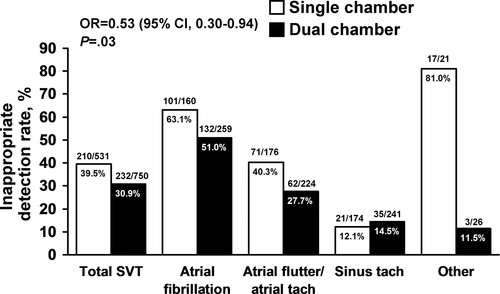
Friedman et al. Dual-Chamber Versus Single-Chamber Detection Enhancements for Implantable Defibrillator Rhythm Diagnosis. The Detect Supraventricular Tachycardia Study. Circulation. 2006;113:2871–2879. https://doi.org/10.1161/CIRCULATIONAHA.105.594531
Difference is small in real world
- Atrial sensing problems may contribute to inappropriate detection in dual chamber devices
- Improved algorithms with single chamber devices
- Reduction in inappropriate shocks is only for slower rhythms
- Better understanding of device programming - less inappropriate therapies
Gilliam FR et al. Real world evaluation of dual-zone ICD and CRT-D programming compared to single-zone programming: the ALTITUDE REDUCES study. J Cardiovasc Electrophysiol. 2011;22:1023–9. doi: 10.1111/j.1540-8167.2011.02086.x.
DATAS trial
- 334 patients
- Randomised to SC-ICD, DC-ICD or simulated SC-ICD (DC programmed as SC)
- Lower rate of significant clinical events with DC-ICD
- But none of primary endpoints different (not enough statistical power)
Almendral J et al. Dual-chamber defibrillators reduce clinically significant adverse events compared with single-chamber devices: results from the DATAS (Dual chamber and Atrial Tachyarrhythmias Adverse events Study) trial. Europace. 2008;10:528–35. doi: 10.1093/europace/eun072.
RAPTURE
- RCT of 100 patients
- DC-ICD did not reduce inappropriate shocks
Friedman PA et al. A prospective randomized trial of single- or dual-chamber implantable cardioverter-defibrillators to minimize inappropriate shock risk in primary sudden cardiac death prevention. Europace. 2014;16:1460–8. doi: 10.1093/europace/euu022.
Programming
Focused update 2019
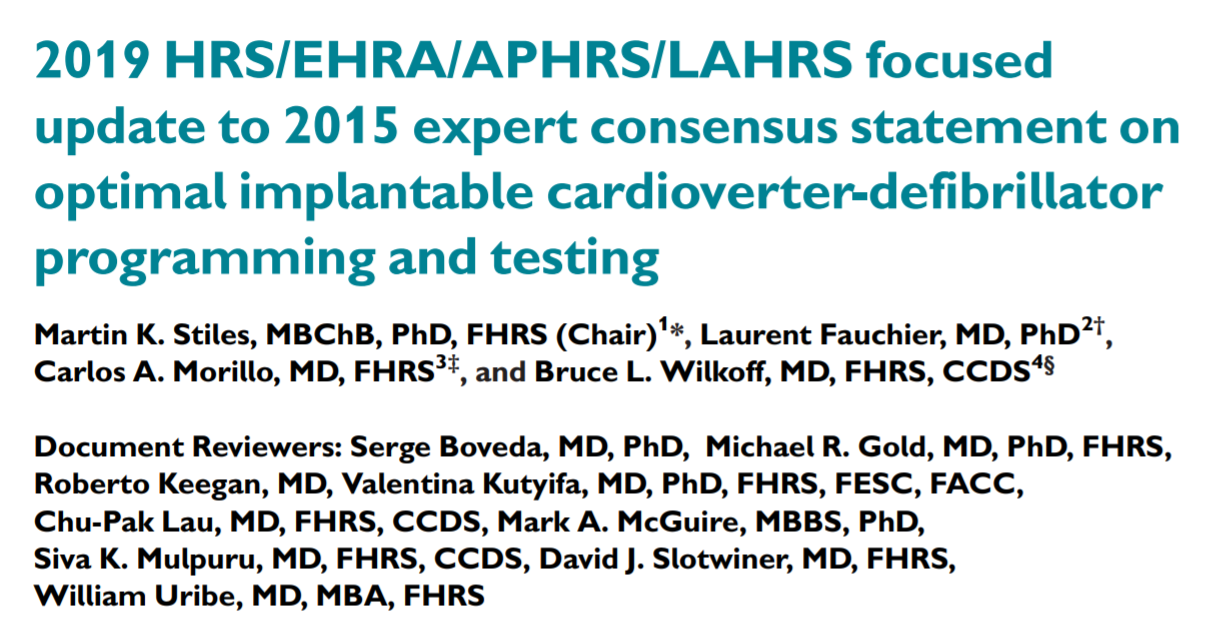
Stiles MK, Fauchier L, Morillo CA, Wilkoff BL; ESC Scientific Document Group. 2019 HRS/EHRA/APHRS/LAHRS focused update to 2015 expert consensus statement on optimal implantable cardioverter-defibrillator programming and testing. Europace. 2019 Sep 1;21(9):1442-1443. doi: 10.1093/europace/euz065. PMID: 31090914.
Brady programming
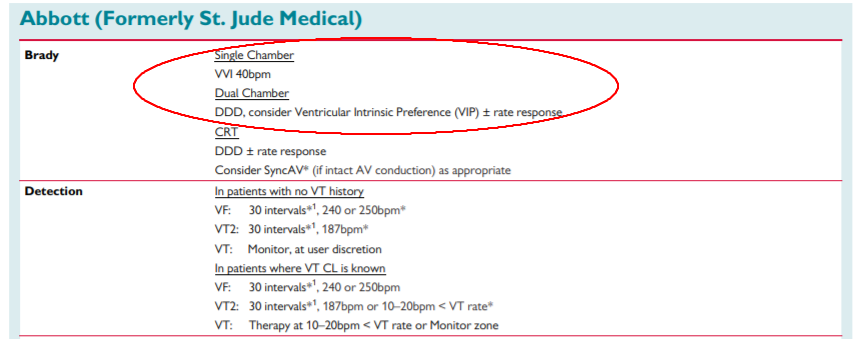
VF detection
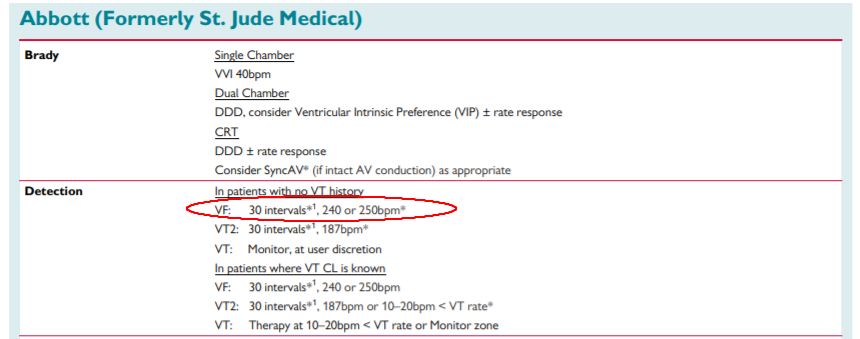
PAINFREE 2
- FVT 188-250 bpm
- Randomised to ATP or shock
- ICM and NICM, primary and secondary prevention
- 72% of VT in this zone could be terminated with ATP
- Improved quality of life with ATP
Wathen MS et al. Prospective randomized multicenter trial of empirical antitachycardia pacing versus shocks for spontaneous rapid ventricular tachycardia in patients with implantable cardioverter-defibrillators: Pacing Fast Ventricular Tachycardia Reduces Shock Therapies (PainFREE Rx II) trial results. Circulation. 2004;110:2591–6. doi: 10.1161/01.CIR.0000145610.64014.E4.
VT detection
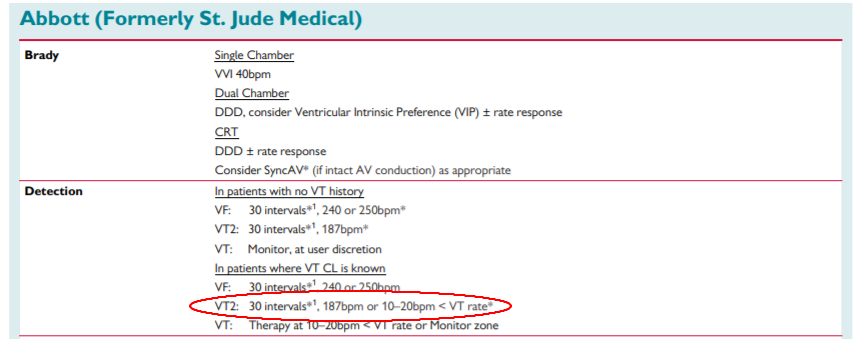
MADIT-RIT
- 1500 patients - 3 arms
- standard programming / VT > 200 / 60 sec delay > 170, 12 sec > 200
- First inappropriate therapy
Moss AJ et al. Reduction in inappropriate therapy and mortality through ICD programming. N Engl J Med. 2012;367:2275–83. doi: 10.1056/NEJMoa1211107.
MADIT-RIT
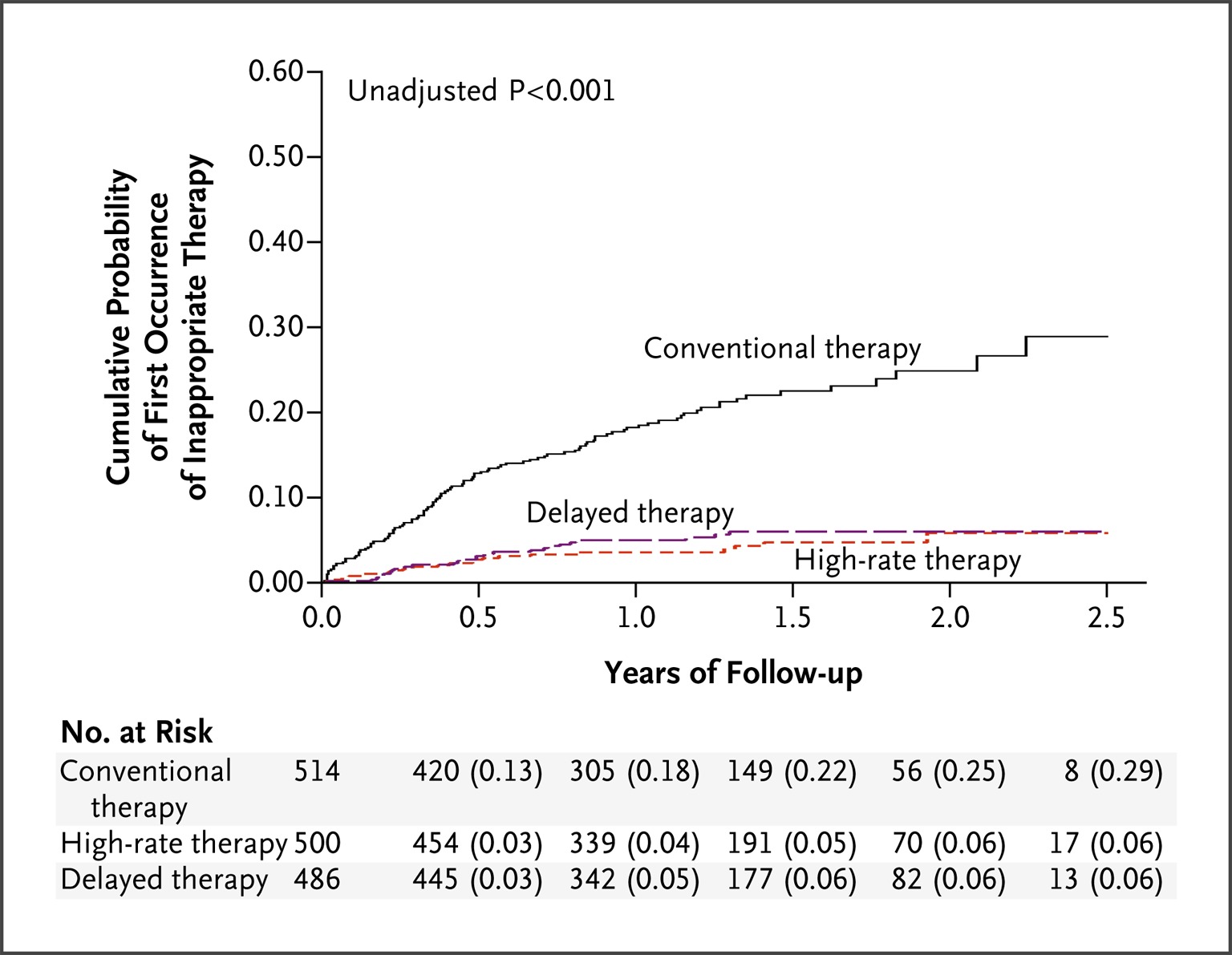
ATP for "VF"

Personal experience
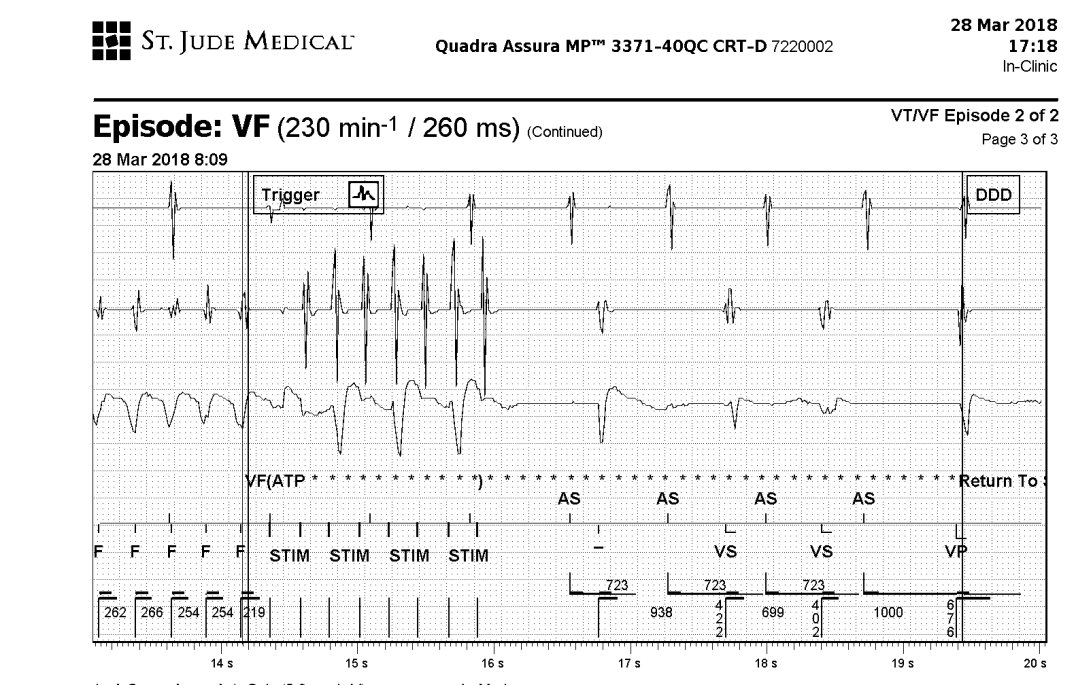
Shocks for VF

ATP for VT

PREPARE trial
- ATP for FVT (182-250 bpm) in primary prevention ICDs
- Cohort of 700 patients
- Historic controls (EMPIRIC and MIRACLE-ICD)
- First shock in 12 mths reduced from 17% to 9%
Wilkoff BL et al. Strategic programming of detection and therapy parameters in implantable cardioverter-defibrillators reduces shocks in primary prevention patients: results from the PREPARE (Primary Prevention Parameters Evaluation) study. J Am Coll Cardiol. 2008;52:541–50. doi: 10.1016/j.jacc.2008.05.011.
PITAGORA
- 206 pts randomised to ramp or burst for fast VT
- Better success with burst (75% vs 56%)
Gulizia MM et al. A randomized study to compare ramp versus burst antitachycardia pacing therapies to treat fast ventricular tachyarrhythmias in patients with implantable cardioverter defibrillators: the PITAGORA ICD trial. Circ Arrhythm Electrophysiol. 2009;2:146–53. doi: 10.1161/CIRCEP.108.804211.
Discriminators
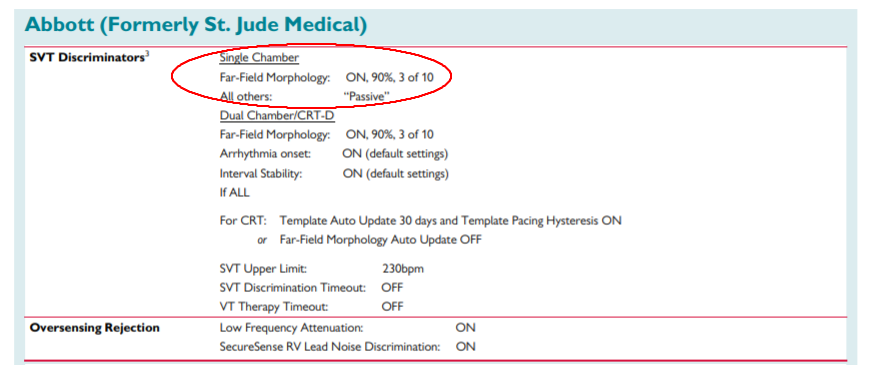
SVT time out
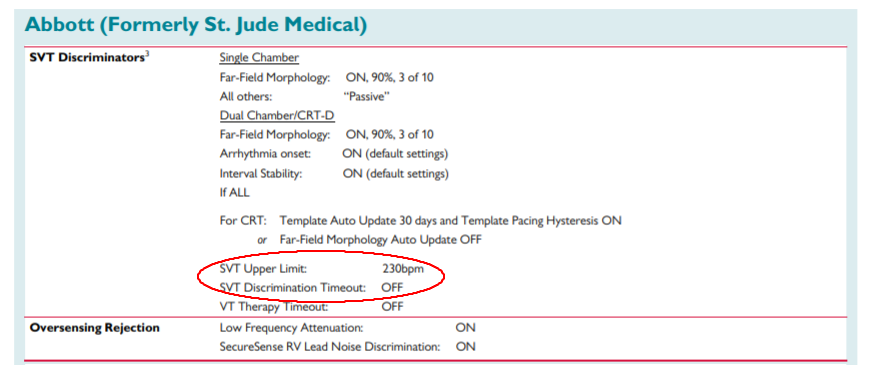
Noise rejection / Lead integrity alerts
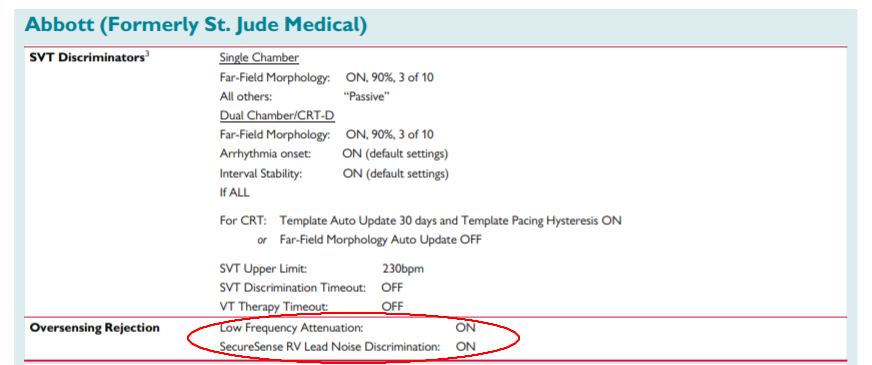
Summary
- ICD is not a treatment for VT
- Dual chamber ICD does not appear justified for better discrimination
- Ensure good R wave and small T wave
- Program high VF rate - 250 bpm
- Long detection interval for VT
- ATP - during charging for VF, more than one attempt for VTs